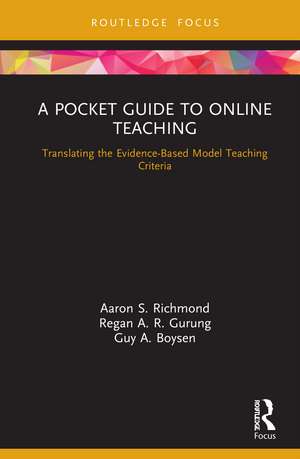A Pocket Guide to Online Teaching: Translating the Evidence-Based Model Teaching Criteria
Autor Aaron S. Richmond, Regan A. R. Gurung, Guy Boysenen Limba Engleză Hardback – 9 mar 2021
Guided by the Model Teaching Characteristics created by The Society for the Teaching of Psychology, this book covers important topics like: how to adapt to expected and unexpected changes in teaching, how to evaluate yourself and your peers, and tips on working smarter/optimizing working practices with the resources available. The features of the book include:
- Practical examples exploring how to solve the typical problems of designing and instructing online courses.
- Interactive "Worked Examples" and "Working Smarter" callouts throughout the book which offer practical demonstrations to help teachers learn new skills.
- Further reading and resources to build on knowledge about online education.
- End of chapter checklists which summarizes suggestions about how to be a model online teacher.
Preț: 465.91 lei
Nou
Puncte Express: 699
Preț estimativ în valută:
89.22€ • 91.93$ • 74.87£
89.22€ • 91.93$ • 74.87£
Carte tipărită la comandă
Livrare economică 22 februarie-08 martie
Preluare comenzi: 021 569.72.76
Specificații
ISBN-13: 9780367646684
ISBN-10: 0367646684
Pagini: 84
Ilustrații: 8
Dimensiuni: 152 x 229 x 10 mm
Greutate: 0.45 kg
Ediția:1
Editura: Taylor & Francis
Colecția Routledge
Locul publicării:Oxford, United Kingdom
ISBN-10: 0367646684
Pagini: 84
Ilustrații: 8
Dimensiuni: 152 x 229 x 10 mm
Greutate: 0.45 kg
Ediția:1
Editura: Taylor & Francis
Colecția Routledge
Locul publicării:Oxford, United Kingdom
Public țintă
Postgraduate and ProfessionalCuprins
Dedication
Preface
1. Apples and Oranges, But Still Fruit: Model Teaching Universals and Differences
1.1. Confessions of Three Skeptical Teachers
1.3. Tips For Continued Learning About Model Online Teaching
2. Students Interaction with Content
2.1. Adapting Student Interaction with Content in Online CourseInteraction with Content Through Student Learning Objectives
2.3. Tips For Continued Learning About Students Interacting with Content
3. Student to Student Interaction
3.1. Adapting Student-to-Student Interaction: How to Build a Community of Online Learners
3.3. Tips For Continued Learning About Student-to-Student Interactions
4. Instructor-to-Student Interaction
4.1. Adapting to Online Instruction to Promote Instructor to Student Interaction
4.3. Tips For Continued Learning About Online Instructor-to-Student Interaction
5. Online Assessment
5.1. How to Adapt Assessment to Online Instruction
a. The Process of Assessing Student Learning Online
Communicating Learning Objectives
Alignment of Learning Objectives, Assignments, and Activities
Providing Constructive Feedback Online
Making Assessment-based Changes
b. Teaching Effectiveness Assessment Process
5.2. Stop, Think, Reflect: The Model Online Teaching Checklist for Assessment
5.3. Tips for Continued Learning About Online Assessment
References
Index
Preface
1. Apples and Oranges, But Still Fruit: Model Teaching Universals and Differences
1.1. Confessions of Three Skeptical Teachers
- The Background of Model Teaching
- What is Model Teaching?
- How is Teaching Different Online?
- Becoming a Model Online Teacher
1.3. Tips For Continued Learning About Model Online Teaching
2. Students Interaction with Content
2.1. Adapting Student Interaction with Content in Online CourseInteraction with Content Through Student Learning Objectives
- The Syllabus and Your LMS is a Vehicle for Course Content
- Interaction with Content Depends on Course Design, Structure, and Clarity
- Model Online Teachers use Course Templates to Organize Content
- Special Considerations for Online Interactions with Content
- Broadening Instructional Methods
2.3. Tips For Continued Learning About Students Interacting with Content
3. Student to Student Interaction
3.1. Adapting Student-to-Student Interaction: How to Build a Community of Online Learners
- Establishing Student-to-Student Interaction Through Discussions ForumsFostering Student Community with Online Discussion
Communicating Discussion Expectations
Fostering Student Learning with Online Discussion - Create Collaborative and Cooperative Online Learning Opportunities
- Establishing a Community of Learners Necessitates Mitigation of Student-to-Student Conflict
3.3. Tips For Continued Learning About Student-to-Student Interactions
4. Instructor-to-Student Interaction
4.1. Adapting to Online Instruction to Promote Instructor to Student Interaction
- Use the Syllabus to Interact with Students
- Use Various Instructional Methods and Skills to Interact with Students
- Practice Effective Online Teaching Skills
- The Great Debate: Do Model Online Teachers use Synchronous or Asynchronous Learning?
- Interact with Students via Student Evaluations of Teaching
- Interact with Students Through Student Feedback
4.3. Tips For Continued Learning About Online Instructor-to-Student Interaction
5. Online Assessment
5.1. How to Adapt Assessment to Online Instruction
a. The Process of Assessing Student Learning Online
Communicating Learning Objectives
Alignment of Learning Objectives, Assignments, and Activities
Providing Constructive Feedback Online
Making Assessment-based Changes
b. Teaching Effectiveness Assessment Process
5.2. Stop, Think, Reflect: The Model Online Teaching Checklist for Assessment
5.3. Tips for Continued Learning About Online Assessment
References
Index
Notă biografică
Aaron S. Richmond is a Professor of Educational Psychology at Metropolitan State University of Denver, USA. He studies how humans learn and develop and the application of this knowledge to classroom instruction and assessment.
Regan A. R. Gurung is Professor of Psychological Science and Director of the General Psychology Program at Oregon State University, USA. His research focuses on reducing prejudice, racism, and sexism, and the factors influencing learning.
Guy A. Boysen is a Professor of Psychology at McKendree University, USA. His scholarship emphasizes the teaching of psychology, professional development of teachers, and stigma toward mental illness.
Regan A. R. Gurung is Professor of Psychological Science and Director of the General Psychology Program at Oregon State University, USA. His research focuses on reducing prejudice, racism, and sexism, and the factors influencing learning.
Guy A. Boysen is a Professor of Psychology at McKendree University, USA. His scholarship emphasizes the teaching of psychology, professional development of teachers, and stigma toward mental illness.
Descriere
This pithy yet thorough book provides an evidence-based guide on how to prepare for online teaching, especially for those who are making a swift transition from face-to-face to online instruction.
